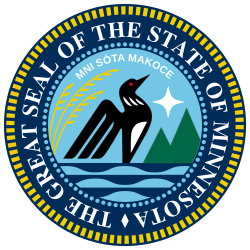Minnesota House of Representatives | |
|---|---|
| 94th Minnesota Legislature | |
 | |
| Type | |
| Type | of the Minnesota Legislature |
Term limits | None |
| History | |
New session started | January 14, 2025 |
| Leadership | |
Speaker Pro Tempore | |
GOP Floor Leader | |
DFL Caucus Leader | |
DFL Floor Leader | |
| Structure | |
| Seats | 134 |
Political groups |
|
Length of term | 2 years |
| Authority | Article IV, Minnesota Constitution |
| Salary | $51,750/year + per diem [2] |
| Elections | |
| First-past-the-post | |
Last election | November 5, 2024 |
Next election | November 3, 2026 |
| Redistricting | Legislative control |
| Meeting place | |
 | |
| House of Representatives chamber Minnesota State Capitol Saint Paul, Minnesota | |
| Website | |
| house | |
| Rules | |
| 23–24 Permanent Rules of the House | |
The Minnesota House of Representatives is the lower chamber of the U.S. state of Minnesota's legislature. It operates in conjunction with the Minnesota Senate, the state's upper chamber, to write and pass legislation, which is then subject to approval by the governor of Minnesota.
Contents
- History
- Elections
- Composition
- Members, 2025–2027
- Historical composition
- Past notable members
- U.S. senators from Minnesota
- Governors of Minnesota
- Lieutenant governors of Minnesota
- Attorneys general of Minnesota
- Treasurers of Minnesota
- U.S. representatives from Minnesota
- Others
- See also
- Notes
- References
- External links
Established in 1858, the Minnesota House of Representatives has 134 members elected from single-member districts across the state. Representatives serve two-year terms without term limits, with all seats up for election every two years. The House is led by the Speaker, who is elected by members of the House, while political party leadership is governed by the Majority and Minority Leaders.
The Minnesota House of Representatives meets in the north wing of the State Capitol in Saint Paul. Member and staff offices, as well as most committee hearings, are in the nearby State Office Building.


